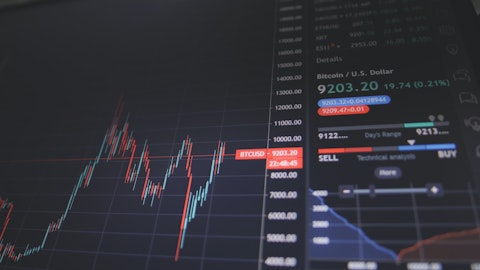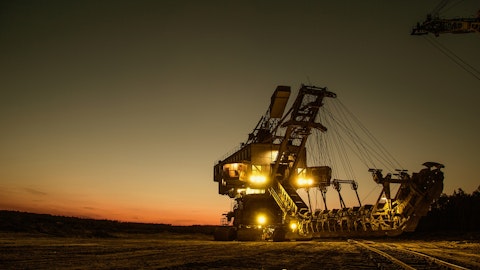Marco Levi: Well, I’m not sure I understood your question. We closed the first half of the year at $155 million EBITDA. We are the $104 million in Q3, so we are at $259 million. So we feel pretty comfortable to close the year. On the high side of our guidance, this is what I can say. Your question, Commerce. I think you asked also about first quarter 2024. We are in the middle of the budgeting process. Of course, we are like everybody else, we are facing a lot of challenges, right. Because pricing during this year has been going down. So we need to make our assumptions for next year. And like we already said in the previous calls, the very favorable impact of the energy contract in France this year will not be so big next year due to the fact that market price for energy is lower compared to the beginning of this year.
So pricing, we are at the bottom. We are going to have still a very competitive position in France, but less advantage than this year. On the other side, I think we are looking with a lot of optimism that increased sales position in Asia of silicon metal. So these are the main factors. The other key positive that I want to mention is that the fact that, and I already mentioned that in my presentation, is that we have spent CapEx very well in the last two years. You know that in the last two years we spent $75 million, $80 million of CapEx versus $30 million, $35 million in the previous couple of years. Well, our plan has what? Run much better, like I said in my presentation. So we have the opportunity to count on more reliable assets, and this guild is going to give us much more flexibility in terms of volume allocation
Martin Englert: Appreciate the optionality on the production footprint there. Thanks for highlighting that again. One last one, if I could. You did provide annual EBITDA guidance for this year. Is that something that you’ve determined internally that you’ll provide again for the upcoming year, or was that a one off?
Marco Levi: Well, we will provide guidance. We haven’t decided yet which guidance, because we are working, like I said, on the budget, revising our business plans, and we will need to discuss with our Board. But I think once you have started giving guidance, you have to continue to give a certain guidance. So we will do that.
Martin Englert: Appreciate it and congratulations navigating the market and results.
Marco Levi: Thank you, Martin.
Operator: Thank you. We will now take the next question from the line of Lucas Pipes from B. Riley Securities. Please go ahead.
Lucas Pipes: Thank you very much for taking my follow up question. It’s on the quartz investment. If I heard you right there in the prepared remarks, it’s going to be a total of $50 million. And you mentioned, Marco, I think 15% cost reductions associated with that. I assume there are some other strategic benefits, but just in terms of the numbers, in terms of the expected rate of return, is there a range that you could maybe provide for the market? Would be really helpful to get a feel for that. Thank you very much.
Marco Levi: Again, when you mentioned $50 million, you were cut. So I want to make sure that I understood your question correctly.
Alex Rotonen: Lucas, it’s Alex. Were you asking if the investment of $15 million. It’s 15, about $11 million?
Lucas Pipes: Yes. Maybe I didn’t hear that right. The question is really first and foremost about the expected rate of return.
Beatriz García-Cos: On the mine.
Marco Levi: On the mine.
Lucas Pipes: That’s correct.
Marco Levi: Yes. I think we need to.
Beatriz García-Cos: We can revert back on, and reverb back.
Marco Levi: On this number, but the key point about this mine, is security of supply of quartz, the right quality of quartz, $11 million investment, plus $4 million to operate the mine, and an expected cost for our course back integration. That is going to be 10%, 15% lower than our current facility. And there is an enormous advantage in terms of proximity to our plans. Alex, you want to add something.
Alex Rotonen: The IRR is clearly, it’s meaningfully above our cost of capital. And I don’t know if we ever kind of said where our rates are, so maybe we’ll decide on that, but I don’t think we want to disclose it publicly at this time.
Lucas Pipes: I appreciate that. I’ll try to find out what costs are and then apply that 15% savings. But I appreciate the color.
Marco Levi: More than to IFRS 12%. Okay. The IRR is higher than 12.5%.
Lucas Pipes: That is helpful. Thank you. Marco. Final question for me for today, I think you said Marco, on your prepared remarks. Q4 is going to be above. Sorry. It’s going to below first quarter results. There’s still a bit of a range in terms of high end, low end of EBITDA, and I wondered if you could point us to the remaining risk factors between kind of now and year end. We’re almost halfway through the fourth quarter. That could push us towards the lower or the higher end of that implied fourth quarter EBITDA range. Thank you. Thank you very much.
Marco Levi: We are at $259 million EBITDA year to date. We gave a guidance of $270 million, $300 million in the first quarter. We are going to operate some of our plants at a lower rate to control inventories. This is not going to be the case for silicon metal in Europe. In view of our shutdown in France in the first quarter, the advantage on the energy contact in France is going to be lower in the fourth quarter versus Q2 and Q3. And I wouldn’t classify like a risk, but is the fact that quarter four is always a slower quarter due to the December month. So this is where we are. Of course, we have an impact related to the weaker index prices across our portfolio in Q3 that are going to impact pricing, contract pricing in Q4. These are the main things that I see. I don’t know. Beatriz, if you see anything else.
Beatriz García-Cos: No, nothing to add to that. Lucas.
Lucas Pipes: Marco, Beatriz, Alex, really appreciate all the color. Keep up the good work. Thank you.
Marco Levi: Thank you.
Beatriz García-Cos: Thanks, Lucas.
Operator: Thank you. We will now take the next question from the line of Greg Benoit, Shareholder. Please go ahead.
Unidentified Analyst: Good morning or good afternoon. Thank you for the great results. The quartz mine that you bought South Carolina. I’m just curious, how much competition is there for assets like this? I would think that. Are these very difficult to find high quality quartz mine in America?
Marco Levi: Well, we’ve been lucky enough to find it, and probably you refer to a blog that I am aware about where there are some controversial opinions about the opportunity. But we are experts in this field. We know what we are doing. When you acquire a mine, you need to make sure that.



